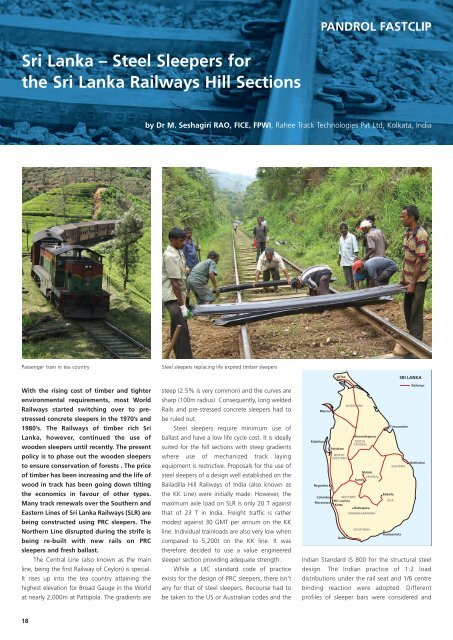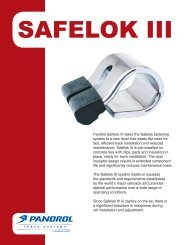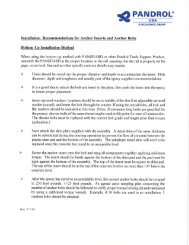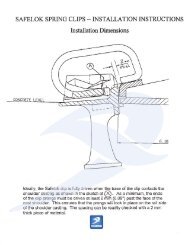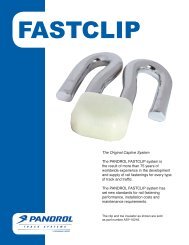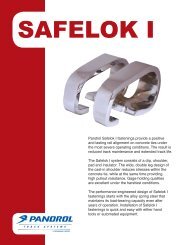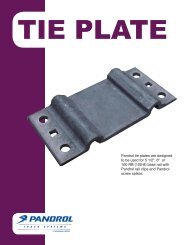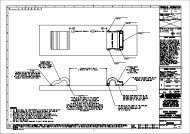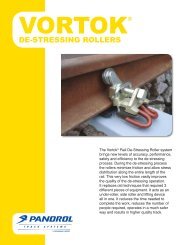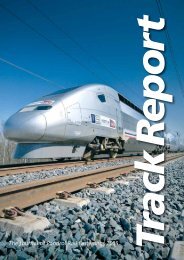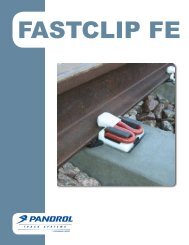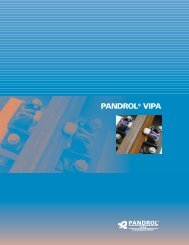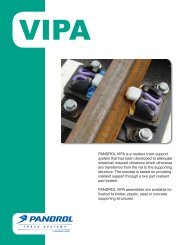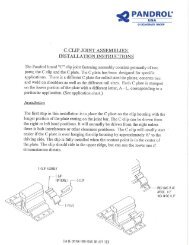The Journal of Pandrol Rail Fastenings 2011 - Pandrol USA
The Journal of Pandrol Rail Fastenings 2011 - Pandrol USA
The Journal of Pandrol Rail Fastenings 2011 - Pandrol USA
Create successful ePaper yourself
Turn your PDF publications into a flip-book with our unique Google optimized e-Paper software.
PANDROL FASTCLIP<br />
Sri Lanka – Steel Sleepers for<br />
the Sri Lanka <strong>Rail</strong>ways Hill Sections<br />
by Dr M. Seshagiri RAO, FICE, FPWI, Rahee Track Technologies Pvt Ltd, Kolkata, India<br />
Passenger train in tea country<br />
Steel sleepers replacing life expired timber sleepers<br />
With the rising cost <strong>of</strong> timber and tighter<br />
environmental requirements, most World<br />
<strong>Rail</strong>ways started switching over to prestressed<br />
concrete sleepers in the 1970’s and<br />
1980’s. <strong>The</strong> <strong>Rail</strong>ways <strong>of</strong> timber rich Sri<br />
Lanka, however, continued the use <strong>of</strong><br />
wooden sleepers until recently. <strong>The</strong> present<br />
policy is to phase out the wooden sleepers<br />
to ensure conservation <strong>of</strong> forests . <strong>The</strong> price<br />
<strong>of</strong> timber has been increasing and the life <strong>of</strong><br />
wood in track has been going down tilting<br />
the economics in favour <strong>of</strong> other types.<br />
Many track renewals over the Southern and<br />
Eastern Lines <strong>of</strong> Sri Lanka <strong>Rail</strong>ways (SLR) are<br />
being constructed using PRC sleepers. <strong>The</strong><br />
Northern Line disrupted during the strife is<br />
being re-built with new rails on PRC<br />
sleepers and fresh ballast.<br />
<strong>The</strong> Central Line (also known as the main<br />
line, being the first <strong>Rail</strong>way <strong>of</strong> Ceylon) is special.<br />
It rises up into the tea country attaining the<br />
highest elevation for Broad Gauge in the World<br />
at nearly 2,000m at Pattipola. <strong>The</strong> gradients are<br />
steep (2.5% is very common) and the curves are<br />
sharp (100m radius). Consequently, long welded<br />
<strong>Rail</strong>s and pre-stressed concrete sleepers had to<br />
be ruled out.<br />
Steel sleepers require minimum use <strong>of</strong><br />
ballast and have a low life cycle cost. It is ideally<br />
suited for the hill sections with steep gradients<br />
where use <strong>of</strong> mechanized track laying<br />
equipment is restrictive. Proposals for the use <strong>of</strong><br />
steel sleepers <strong>of</strong> a design well established on the<br />
Bailadilla Hill <strong>Rail</strong>ways <strong>of</strong> India (also known as<br />
the KK Line) were initially made. However, the<br />
maximum axle load on SLR is only 20 T against<br />
that <strong>of</strong> 23 T in India. Freight traffic is rather<br />
modest against 30 GMT per annum on the KK<br />
line. Individual trainloads are also very low when<br />
compared to 5,200t on the KK line. It was<br />
therefore decided to use a value engineered<br />
sleeper section providing adequate strength.<br />
While a UIC standard code <strong>of</strong> practice<br />
exists for the design <strong>of</strong> PRC sleepers, there isn’t<br />
any for that <strong>of</strong> steel sleepers. Recourse had to<br />
be taken to the US or Australian codes and the<br />
Indian Standard IS 800 for the structural steel<br />
design. <strong>The</strong> Indian practice <strong>of</strong> 1:2 load<br />
distributions under the rail seat and 1/6 centre<br />
binding reaction were adopted. Different<br />
pr<strong>of</strong>iles <strong>of</strong> sleeper bars were considered and<br />
18


